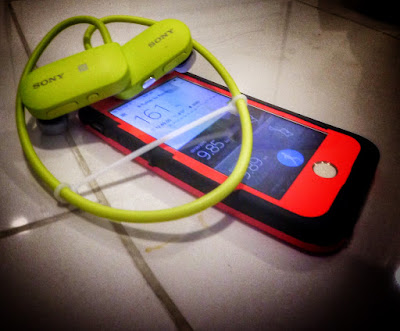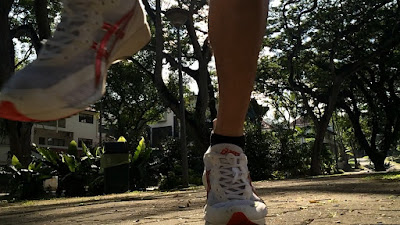KEY FEATURES: SONY’S SMART B-TRAINER™
Sony’s Smart B-Trainer™ is packed with six types of sensors – heart
rate, acceleration, GPS, compass, gyroscope and barometer, and records 11 types
of running metrics – heart rate, burned calories, distance, time, speed, pace,
cadence, steps, stride, running route and elevation. Here, I
shall focus on three main features which I feel give it a big edge over the
competition: standalone GPS tracking capability; built-in heartrate (HR) monitoring;
intelligent music playback and real-time voice coaching.
GPS
capability
I’ll start with the GPS tracking
capability. As far as I know, it’s the only running headphone on the market
which does not require concomitant use of a smartphone to provide GPS tracking
capability. I know many runners, myself included, who hate to run with a
cumbersome phone. While modern GPS watches have shrunk in size quite a bit in
recent years, they still tend to weigh more than the average conventional
watch, not to mention the fact that you have to glance at your (swinging) wrist
to catch a glimpse of the data. I’ve been pleasantly surprised by the quality
of the GPS tracker in Sony’s Smart B-Trainer™. I don’t think I’ve ever had to wait
for more than ~30s for it to capture a satellite signal, on par with the best
of the GPS watches on the market. In terms of accuracy of data, the distance
lap splits generated by Sony’s Smart B-Trainer™ are very close to my Garmin GPs
watch (usually less than 5s difference), and the total distance covered is also
within the recognized margin of error for GPS watches.
Above is the data from one of my
recent runs where I used Sony’s Smart B-Trainer™ and a Garmin Vivoactive GPS watch
concurrently. Data on the left is from the Smart B-Trainer™ and data
from the right is from the Garmin.
Heartrate Monitoring capability
Sony’s Smart B-Trainer™ monitors
your HR by means of an infrared sensor pod incorporated into the right
ear-piece. A HR sensor of this nature is not unlike a finger pulse oximeter
used in a medical setting. It relies on an infrared sensor to detect minute
changes in the red spectrum of light radiation from the skin surface to
calculate HR. (In theory it might even be capable of calculating your real-time
oxygen saturation!) This part gets a bit technical, but basically blood gets
pumped around the body in pulses from the heart and so there will be periods of
“low-tide” and periods of “high-tide”. “High-tide” corresponds to a darker
redness in the skin that corresponds to a specific range of light radiation and
vice versa for “low-tide”. The sensor measures the frequency of fluctuations
between low and high tide to calculate HR. Sounds easy enough right? Well it
actually takes a lot of accuracy to be able to detect fluctuations at up to 200
beats a minute, or over 3 fluctuations per second!
The sensor
is protected by a silicone cap. This is the part that perhaps takes a little
trial and error to set up correctly. In my experience, two things contribute to
erratic or abnormally high HR readings: a) water/sweat getting into the space
between the silicone cap and the infrared sensor, and b) loss of contact
between the sensor and your ear. It took me a while to figure it out, but the
silicone cap serves not only to keep water away from the sensor surface, but
also provides some degree of grip to maintain a more stable contact with the
ear. I found that loosening the silicone cap to let water evaporate from under
the cap between runs helped a lot. In addition, the cap also takes up the
potential space between the sensor and the ear so there is no loss of contact,
and that appears to be the main reason for providing 3 different sizes of
silicone caps. The sizes are demarcated by little dot indentations in the caps;
one dot is smallest (or thinnest) and three dots is largest (or thickest). I
actually found this method quite ingenious. I’ve tried using the Smart
B-Trainer™
using all three size options and the outcome is unequivocal. With the smallest
cap, I lost HR sensor contact for almost the whole run; with the medium cap, I
got reliable HR for ~50% of the run; and with the large cap, I managed to get
accurate and reliable data for essentially the whole run. Unfortunately, the
fit recommendations are highly individual, and one runner I spoke to found that
the smallest cap works best for him. I recommend trying out the different sizes
for short runs to see which gives you the best HR data.
On the left is a sample run I did
recently, and you can see the heartrate was fairly stable in the 160bpm range
which is consistent with what I expected for the level of exertion.
INTELLIGENT MUSIC PLAYBACK AND VOICE COACHING
This feature essentially banks on the principle of using the tempo of the music to influence the way you run, e.g. using a faster music beat to increase your pace and/or cadence subconsciously. I have tried out this feature on a few occasions, and I did find that especially for my easy runs where I want to make sure I do not overexert, a slower tempo of music does indeed help to control my HR within a narrower target range. There are more complex variations of these but they are restricted to the premium training plans (still free-of-charge within the “Smart-B Trainer™ for Running” app) developed by ASICS. On a more practical note, I really like that there is voice-over reporting of time, distance, calories, pace and HR at every kilometre split during the run. (You can actually get an impromptu report of the numbers by pressing the power button on the right side ear-piece, but I find that getting data reports every kilometre is sufficient.) This really saves the hassle of looking at your watch whenever it beeps at the kilometre split, and you really don’t notice the convenience it affords until you have tried using the Smart B-Trainer™. As far as music selection goes, you are free to upload your own choice of music to the Smart B-Trainer™ but I have found the stock selection of beats more than sufficient for its purposes.
 Here you can see that for every
10bpm HR range, there is a different selection of tunes to match your pace.
Here you can see that for every
10bpm HR range, there is a different selection of tunes to match your pace.
Sony’s Smart B-Trainer™ is
currently retailing at S$399, in five colours (yellow, white, blue, pink and
black) and is sold at all Sony Store, Sony Centre, specialist dealers or
retailers. Head on over to any of these stores to give them a try.






Try now for the SM110 Finger Pulse Oximeter for the better and instant results.
ReplyDeleteKey Features: Sony’S Smart B-Trainer™ >>>>> Download Now
ReplyDelete>>>>> Download Full
Key Features: Sony’S Smart B-Trainer™ >>>>> Download LINK
>>>>> Download Now
Key Features: Sony’S Smart B-Trainer™ >>>>> Download Full
>>>>> Download LINK eo
Thank you for your consistent commitment to delivering quality content. Your contributions are making a positive difference, and I genuinely appreciate your efforts. buy wireless headphones
ReplyDelete